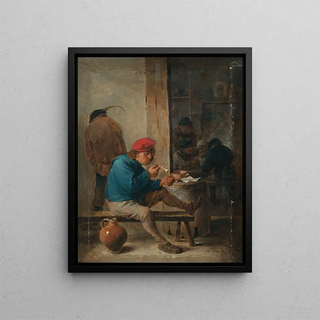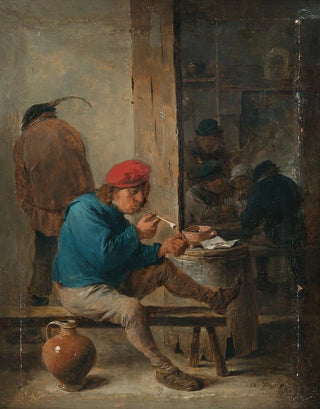Art print Tavern scene with smokers - David Teniers the Younger | Art print


View from behind

Frame (optional)
In the vibrant world of 17th-century Flemish art, the "Tavern scene with smokers" by David Teniers the Younger stands out for its lively and warm atmosphere. This art print, which captures the very essence of daily life at the time, transports us to a world where time seems to stand still. The characters, immersed in their convivial activities, evoke an atmosphere of camaraderie and lightheartedness. The work, through its realism and precision, invites us to contemplate not only the depicted scene but also the subtleties of human interactions taking place. Through this art print, we can appreciate Teniers' mastery and his talent for immortalizing moments of life.
Style and uniqueness of the work
Teniers' style is characterized by a keen sense of detail and a color palette that evokes the warmth of Flemish interiors. In "Tavern scene with smokers," the artist succeeds in creating a dynamic composition where each character seems to have their own story. The smokers, absorbed in their reflections or exchanges, are depicted with such authenticity that one could almost hear their laughter echoing. The carefully orchestrated light illuminates the faces and objects, adding an almost tactile dimension to the canvas. This art print also stands out for its ability to capture popular life, far from the noble subjects often favored by his contemporaries. Teniers, with his sharp eye, offers us a valuable glimpse into the society of his time, making his work timeless and universal.
The artist and his influence
David Teniers the Younger, son of the artist David Teniers the Elder, established himself as one of the masters of Flemish painting. Trained in a rich artistic environment, he developed a style that combines realism and sensitivity. His work reflects not only his talent but also the cultural vibrancy of his era. Teniers managed to capture daily life with such finesse that he influenced many artists, both in Flanders and beyond. His ability to depict genre scenes, where popular life is highlighted

Matte finish

View from behind

Frame (optional)
In the vibrant world of 17th-century Flemish art, the "Tavern scene with smokers" by David Teniers the Younger stands out for its lively and warm atmosphere. This art print, which captures the very essence of daily life at the time, transports us to a world where time seems to stand still. The characters, immersed in their convivial activities, evoke an atmosphere of camaraderie and lightheartedness. The work, through its realism and precision, invites us to contemplate not only the depicted scene but also the subtleties of human interactions taking place. Through this art print, we can appreciate Teniers' mastery and his talent for immortalizing moments of life.
Style and uniqueness of the work
Teniers' style is characterized by a keen sense of detail and a color palette that evokes the warmth of Flemish interiors. In "Tavern scene with smokers," the artist succeeds in creating a dynamic composition where each character seems to have their own story. The smokers, absorbed in their reflections or exchanges, are depicted with such authenticity that one could almost hear their laughter echoing. The carefully orchestrated light illuminates the faces and objects, adding an almost tactile dimension to the canvas. This art print also stands out for its ability to capture popular life, far from the noble subjects often favored by his contemporaries. Teniers, with his sharp eye, offers us a valuable glimpse into the society of his time, making his work timeless and universal.
The artist and his influence
David Teniers the Younger, son of the artist David Teniers the Elder, established himself as one of the masters of Flemish painting. Trained in a rich artistic environment, he developed a style that combines realism and sensitivity. His work reflects not only his talent but also the cultural vibrancy of his era. Teniers managed to capture daily life with such finesse that he influenced many artists, both in Flanders and beyond. His ability to depict genre scenes, where popular life is highlighted
12,34 €






